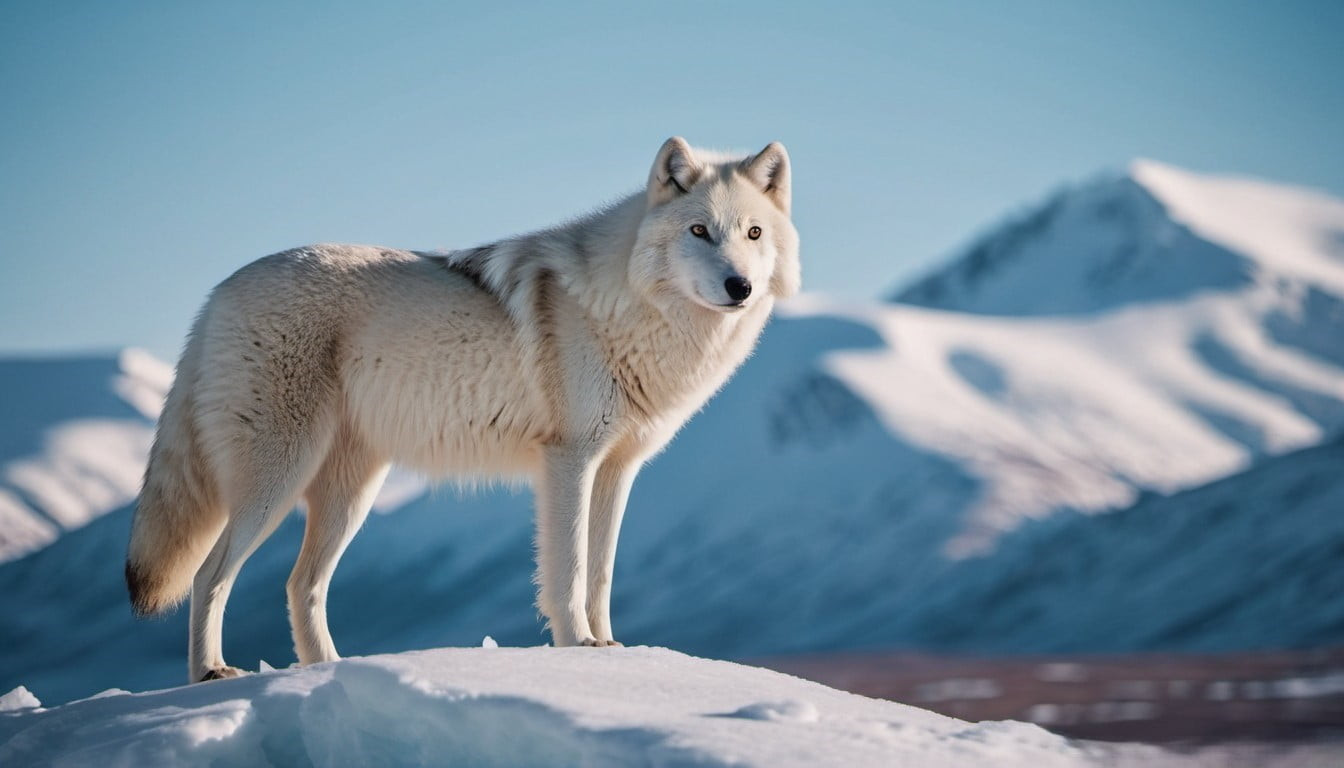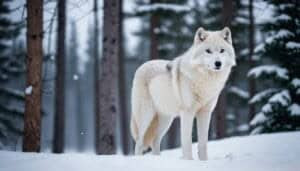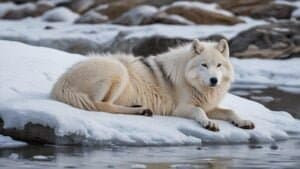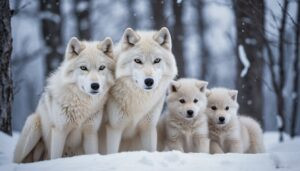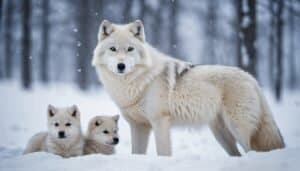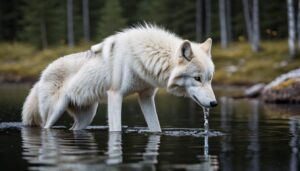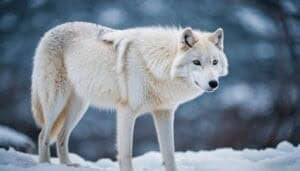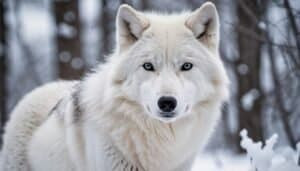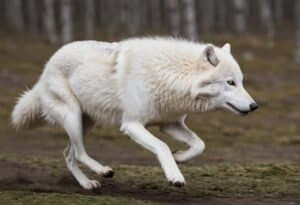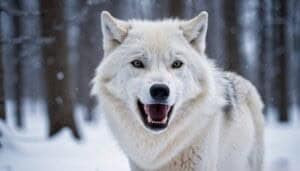Introduction
Understanding the lifespan of Arctic wolves in the wild involves examining various factors that influence their longevity. This article delves into the environmental conditions, diet, social structure, and human impacts that affect these resilient animals
We will also explore gender differences in lifespan, common health issues, and the effects of climate change on Arctic wolves. Through this comprehensive overview, we aim to provide a clear picture of the life expectancy of these fascinating creatures in their natural habitat
Factors Affecting the Lifespan of Arctic Wolves
Arctic wolves, also known as white wolves or polar wolves, inhabit some of the harshest environments on Earth. Their lifespan in the wild is influenced by several key factors that dictate their survival and longevity
Environmental Conditions
Arctic wolves thrive in the frigid climates of the High Arctic, where temperatures can plunge to extreme lows, and the landscape is often covered in snow and ice. These environmental conditions play a significant role in determining the lifespan of Arctic wolves
The scarcity of prey during the long, harsh winters can lead to malnutrition and starvation, significantly impacting their survival rates. Moreover, the extreme weather conditions can cause hypothermia and other cold-related health issues, further reducing their lifespan
The availability of shelter is another critical factor. Arctic wolves often seek refuge in caves, dens, or under overhanging rocks to protect themselves from the elements. A lack of adequate shelter can expose them to severe weather conditions, increasing their vulnerability to the harsh environment
Diet and Nutrition
The diet of Arctic wolves primarily consists of large herbivores such as musk oxen and Arctic hares. The availability of prey is crucial for their survival. During times of prey scarcity, which can be caused by environmental changes or competition with other predators, Arctic wolves may struggle to find enough food to sustain themselves. This nutritional deficit can lead to weakened immune systems, making them more susceptible to diseases and reducing their overall lifespan
Additionally, the hunting success of Arctic wolves can be influenced by the size and health of their pack. Larger packs can take down bigger prey, ensuring a more consistent food supply. However, smaller packs or lone wolves may face challenges in capturing sufficient food, impacting their longevity
Predation and Threats
While Arctic wolves are apex predators in their environment, they are not without threats. Intra-species aggression can sometimes lead to injuries or death, particularly during territorial disputes or fights for dominance within the pack
Additionally, Arctic wolves may occasionally fall prey to larger predators such as polar bears, although such instances are rare
Human activities also pose a significant threat to Arctic wolves. Hunting, habitat encroachment, and climate change driven by human actions can all adversely affect their lifespan. While direct hunting of Arctic wolves is less common due to their remote habitats, any increase in human presence can disrupt their natural behavior and access to prey
Social Structure and Gender Differences
The social dynamics and gender roles within Arctic wolf packs significantly impact their lifespan. Understanding these aspects provides insight into how these wolves navigate their challenging environment
Pack Dynamics
Arctic wolves live in packs that typically consist of a dominant breeding pair (the alpha male and female) and their offspring. This social structure is crucial for survival, as it enhances their ability to hunt large prey and provides protection against threats. The cooperative nature of pack life allows for the sharing of responsibilities, such as hunting, pup-rearing, and defending territory, which collectively contribute to the overall health and longevity of the pack members
The stability of a pack’s hierarchy is essential. Disputes over dominance can lead to fights, resulting in injuries or even death. A well-structured pack with clear leadership tends to be more successful in hunting and less prone to internal conflicts, thereby increasing the lifespan of its members
Role of Alpha Wolves
The alpha wolves play a pivotal role in the pack’s survival. They are typically the most experienced and skilled hunters, leading the pack during hunts and ensuring the well-being of all members. The health and longevity of alpha wolves directly affect the pack’s stability and success
Alpha wolves often enjoy a longer lifespan compared to subordinate members due to their priority access to food and shelter. Their leadership position also means they are less likely to be involved in dangerous hunting situations or intra-pack conflicts, further enhancing their chances of survival
Male vs. Female Lifespan
In Arctic wolf packs, there are observable differences in the lifespan between males and females. Generally, male Arctic wolves may have slightly shorter lifespans due to their involvement in territorial disputes and the physical demands of hunting. These activities increase their risk of injury and stress, which can reduce their longevity
Females, especially the alpha females, often have a slightly longer lifespan. Their primary role in the pack includes nurturing and raising pups, which, while demanding, exposes them to fewer immediate dangers compared to hunting. However, the reproductive responsibilities can also take a toll on their health, particularly during harsh seasons when food is scarce
Reproductive Roles
Reproductive roles within the pack also influence lifespan. The alpha pair is usually the only breeding pair in the pack, with the alpha female giving birth to and caring for pups. This role is vital for the pack’s continuation but can be physically taxing. Successful reproduction and pup-rearing ensure the pack’s future and the genetic continuity of the alpha pair, indirectly influencing the longevity of the pack members
Pups and younger wolves face the highest mortality rates due to their vulnerability to the harsh environment, predators, and diseases. However, those that survive to adulthood benefit from the protection and support of the pack, increasing their chances of reaching an older age
Human and Environmental Impacts
Human activities and environmental changes have profound effects on the lifespan of Arctic wolves. Understanding these impacts helps in assessing the challenges faced by these predators and the measures needed to ensure their survival
Habitat Destruction
Habitat destruction poses a significant threat to Arctic wolves. As human activities expand into previously untouched Arctic regions, the natural habitats of these wolves are increasingly disrupted. Industrial activities such as mining, oil drilling, and infrastructure development can lead to habitat fragmentation, which reduces the available hunting grounds and prey for Arctic wolves
This loss of habitat forces wolves into smaller areas, increasing competition for limited resources and leading to higher stress levels and reduced lifespans
Conservation Efforts
Efforts to conserve Arctic wolf populations and their habitats are crucial for ensuring their survival. Various organizations and governments are working to protect these wolves through the establishment of protected areas, implementation of hunting regulations, and promotion of sustainable practices. Conservation initiatives also include research and monitoring programs to better understand Arctic wolf behavior, health, and population dynamics
Public awareness and education campaigns are essential in garnering support for conservation efforts. By highlighting the importance of Arctic wolves to the ecosystem and the threats they face, these campaigns can encourage more sustainable interactions with their habitats
Climate Change Impact
Climate change is one of the most significant environmental challenges impacting Arctic wolves. Rising temperatures and changing weather patterns affect the availability of prey and the stability of their habitats
For example, warmer temperatures can lead to reduced ice coverage, altering the distribution of prey species such as caribou and musk oxen. These changes force Arctic wolves to adapt their hunting strategies and travel longer distances to find food, increasing energy expenditure and reducing their overall lifespan
Melting ice and thawing permafrost also affect the structural integrity of denning sites, making it harder for Arctic wolves to find suitable shelter. This exposure to harsh weather conditions can lead to increased mortality rates, particularly among young pups and older wolves
Adaptation Strategies
Arctic wolves exhibit remarkable adaptability to survive in their changing environment. They may alter their hunting techniques, dietary preferences, and migration patterns in response to environmental shifts
For example, Arctic wolves have been observed preying on different species or scavenging more frequently when traditional prey is scarce. These behavioral adaptations are crucial for their survival but can also place additional stress on the wolves, potentially impacting their health and lifespan
Adaptation also involves changes in social structure and pack dynamics. Packs may become more fluid, with individuals joining or leaving more frequently as they search for better hunting grounds or more stable environments. This flexibility helps Arctic wolves navigate their challenging environment but can also lead to increased competition and conflict within and between packs
Health Issues in Arctic Wolves
Health is a crucial determinant of the lifespan of Arctic wolves. Various diseases, parasites, and infections can significantly impact their survival in the wild
Common Diseases
Arctic wolves are susceptible to several diseases that can reduce their lifespan. Canine distemper, rabies, and parvovirus are among the most common viral infections affecting these wolves. These diseases can spread rapidly within packs, especially during close-contact activities such as grooming and feeding
Canine distemper affects the respiratory, gastrointestinal, and nervous systems, often leading to severe symptoms and high mortality rates. Rabies, a viral disease transmitted through bites, affects the nervous system, leading to aggression, paralysis, and death. Parvovirus attacks the intestines, causing severe dehydration and often proving fatal, especially in young pups
Preventing these diseases is challenging in the wild. Unlike domesticated dogs, Arctic wolves do not receive vaccinations, making them vulnerable to outbreaks. Monitoring wolf populations for signs of illness and researching potential interventions are essential for conservation efforts
Parasites and Infections
Parasites also pose a significant threat to Arctic wolves. Internal parasites, such as roundworms, hookworms, and tapeworms, can cause malnutrition, weight loss, and weakened immune systems. These parasites are typically transmitted through contaminated food, water, or contact with infected animals
External parasites, including ticks, fleas, and lice, can cause skin irritations, infections, and transmit other diseases. Tick-borne diseases, such as Lyme disease and anaplasmosis, can lead to severe health issues and decreased lifespan in Arctic wolves
The impact of parasites is exacerbated by the harsh Arctic environment, where finding sufficient food and shelter is already a challenge. Infected wolves may struggle to maintain their health and energy levels, making them more susceptible to other threats
Preventive Measures
While preventive measures in the wild are limited, ongoing research and conservation efforts aim to mitigate the impact of diseases and parasites on Arctic wolves. Scientists are studying the epidemiology of these health issues to develop strategies for managing and reducing their prevalence.
Efforts to protect the natural habitats of Arctic wolves also play a role in maintaining their health. Healthy ecosystems support diverse prey populations and reduce the likelihood of wolves encountering contaminated food or water sources. Conservation initiatives that focus on habitat preservation and reducing human encroachment are essential for the overall health and longevity of Arctic wolf populations
Conclusion
Understanding the average lifespan of Arctic wolves in the wild involves examining a variety of factors that influence their survival and longevity. These resilient animals face numerous challenges, from harsh environmental conditions and scarce food resources to intra-species conflicts and threats from predators
However, the social structure of Arctic wolves, particularly the role of alpha wolves, plays a critical role in their survival by enhancing hunting efficiency and providing protection
Gender differences also affect the lifespan of Arctic wolves, with males often facing shorter lifespans due to their involvement in territorial disputes and hunting, while females focus on nurturing and raising pups. Human activities, such as habitat destruction and climate change, further impact their lifespan by altering their natural habitats and prey availability. Conservation efforts are vital to mitigating these impacts and ensuring the survival of Arctic wolves
Health issues, including diseases and parasites, pose significant threats to Arctic wolves, affecting their overall health and reducing their lifespan. Research and conservation efforts are essential to manage and reduce the prevalence of these health issues, thereby supporting the longevity of Arctic wolf populations
By addressing these factors and implementing effective conservation strategies, we can help protect these remarkable animals and ensure their continued existence in the wild
